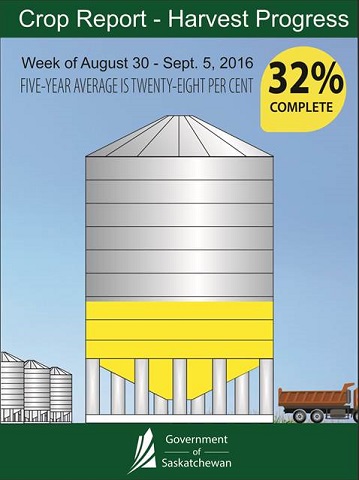Released on September 8, 2016
Saskatchewan producers made good progress with harvest, thanks to a week of primarily dry weather. Thirty-two per cent of the crop has been combined and 38 per cent is swathed or ready to straight-cut, according to Saskatchewan Agriculture’s Weekly Crop Report. This is ahead of the five year (2011-2015) average of 28 per cent combined for this time of year.
Regionally, harvest is furthest advanced in the southeast, where producers have 48 per cent of the crop in the bin. Forty-two per cent of the crop is combined in the southwest, 24 per cent in the east-central region, 25 per cent in the west-central region, 22 per cent in the northeast and 14 per cent in the northwest.
Ninety-four per cent of winter wheat, 85 per cent of field peas, 65 per cent of lentils, 26 per cent of durum, 23 per cent of spring wheat and 17 per cent of canola have been combined.
Yields are estimated to be above the five- and 10-year averages for most crops, with the exception of lentils.
After several dry days, rain showers rolled through the province again on the weekend and have continued into this week.
Precipitation amounts ranged from nil to 30 mm (Raymore area). Areas in the west-central, northwestern and northeastern regions did not receive as much rain as the rest of the province. The Lampman area reported receiving 24 mm, Langenburg 19 mm, Glenavon and Debden 12 mm and Sonningdale eight mm.
Provincially, cropland topsoil moisture is rated as 10 per cent surplus, 84 per cent adequate, five per cent short and one per cent very short. The areas around Kindersley and Tisdale have surplus moisture on 27 and 48 per cent, respectively, of cropland. Hay land and pasture topsoil moisture is rated as four per cent surplus, 85 per cent adequate, nine per cent short and two per cent very short.
Crops are being downgraded because of weathering in the field and higher levels of disease in comparison to other years. There are reports of higher incidences of sclerotinia in canola, fusarium in wheat and durum, and bleaching of cereals and pulses. High winds blew some canola swaths around in the southeast.
Producers are busy harvesting and cutting greenfeed crops.
Follow the 2016 Crop Report on Twitter at @SKAgriculture.
-30-
For more information, contact:
Daphne Cruise
Agriculture
Moose Jaw
Phone: 306-694-3587
Email: daphne.cruise@gov.sk.ca

